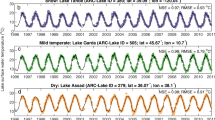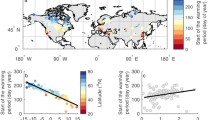Abstract
Long-term data on surface water temperature (SWT) from 9 lakes larger than 10 km2 located in different climatic regions in Austria were analysed for June–September 1965–2009. The lakes are situated north and south of the Alps, in the east bordering Hungary and in the west bordering Germany. Time series of air temperature (AT) and SWT were smoothed by the lowess function and linear trends. Water temperature for the year 2050 was estimated from (1) linear extrapolation of the time trend, (2) projection of the AT–SWT relation and (3) increase of average present day SWT (2000–2009) by 3°C in summer in the Alps as expected from models by climatologists. Results indicate a rise in SWT parallel to AT since the mid-1960s. On an annual basis, changes in water temperature were the greatest in spring and summer. A conservative estimate of the average increase of summer SWT until 2050 is 2°C (1.2–2.9°C), differentiated by region. As a consequence of warming water temperatures, the duration of thermal stratification will increase and mixing and retention time will be affected. Changes in the food web are difficult to forecast, but will strongly depend on local environmental conditions and will therefore be different for individual lakes.





Similar content being viewed by others
References
Arvola, L., G. George, D. M. Livingstone, M. Järvinen, T. Blenckner, M. T. Dokulil, E. Jennings, C. N. Aonghusa, P. Nõges, T. Nõges & G. Weyhenmeyer, 2010. The impact of the changing climate on the thermal characteristics of lakes. In George, G. (ed.), The Impact of Climate Change on European Lakes. Springer, Dordrecht: 85–100. ISBN978-90-461-2944-7.
Bates, B. C., Z. W. Kundzewicz, S. Wu & J. P. Palutikof (eds), 2008. Climate Change and Water. Technical Paper, Intergovernmental Panel on Climate Change, IPCC Secretariat, Geneva: 210 pp.
Bobek, H., W. Kurz & F. Zwitkovits, 1971. Klimatypen 1: 1 000 000. In Kommission für Raum-forschung (ed.), Atlas der Republik Österreich, Tafel III/9. Österreichische Akademie der Wissenschaften, Wien.
Bogataj, L. K., 2007. How will the Alps respond to climate change? Scenarios for the future of alpine water. In Psenner, R. & R. Lackner (eds), Alpine Space, Vol 3: The Water Balance of the Alps. Innsbruck University Press, Innsbruck: 43–51. ISBN 978-3-902571-33-5.
Böhm, R., R. Godina, H.-P. Nachtnebel & O. Pirker, 2008. Mögliche Klimafolgen für die Wasserwirtschaft in Österreich. In ÖWAV (ed.), Auswirkungen des Klimawandels auf die österreichische Wasserwirtschaft, BMLFUW und ÖWAV, Wien: 7–26. www.zamg.ac.at/histalp/downloads/abstract/Boehm-2008b-F.pdf. Accessed 19 Nov 2012.
Brandstetter, S., H. Dürr & H. Frank (eds), 2008. Blue Austria. Federal Ministry of Agriculture, Forestry, Environment and Water Management, Vienna, Austria: 20 pp. http://www.lebens-ministerium.at/publikationen/wasser/wasserwirtschaft_wasserpolitik/Blue-Austria.html. Accessed 19 Nov 2012.
Cosgrove, C. E. & W. J. Cosgrove (eds), 2012. The dynamics of global water futures. Driving forces 2011–2050. WWDR4: 1–100, UNESCO Paris. ISBN 978-92-3-001035-5. http://www.unesdoc.unesco.org/images/0021/002153/215377e.pdf. Accessed 18 Nov 2012.
Dokulil, M. T., 2005. Limnology of Lake Mondsee. In Eisenreich, S. J. (ed.), Climate Change and the European Water Dimension. EC Publication, Luxembourg: 152–154. ISBN 92-894-9005-5. http://book-shop.europa.eu/en/climate-change-and-the-european-water-dimension-pbLBNA21553/. Accessed 18 Nov 2012.
Dokulil, M. T., 2009. Abschätzung der klimabedingten Temperaturänderungen bis zum Jahr 2050 während der Badesaison. Österr, Bundesforste: 52 pp. http://www.oebf.at/uploads/tx_pdforder/Klimastudie_Seen_2009_Dokulil.pdf. Accessed 19 Nov 2012.
Dokulil, M. T., 2013. Environmental impacts of tourism on lakes. In Ansari, A. A. & S. S. Gill (eds), Eutrophication, Causes, Consequences and Control, Vol. 2, Springer, Dordrecht (in press).
Dokulil, M. T. & K. Teubner, 2002. The spatial coherence of alpine lakes. Verhandlungen des Internationalen Verein Limnologie 28: 1861–1864.
Dokulil, M. T. & K. Teubner, 2011. Eutrophication and climate change: present situation and future scenarios. In Ansari, A. A., S. S. Gill, G. R. Lanza & W. Rast (eds), Eutrophication: Causes, Consequences and Control. Springer, Dordrecht: 1–16. doi:10.1007/978-90-481-9625-8_1.
Dokulil, M. T. & K. Teubner, 2012. Deep living Planktothrix rubescens modulated by environmental constraints and climate forcing. Hydrobiologia 698: 29–46. doi:10.1007/s10750-012-1020-5.
Dokulil, M. T., A. Jagsch, G. D. George, A. Anneville, T. Jankowski, B. Wahl, B. Lenhart, T. Blenckner & K. Teubner, 2006. Twenty years of spatially coherent deep-water warming in lakes across Europe related to the North Atlantic Oscillation. Limnology and Oceanography 51: 2787–2793.
Dokulil, M. T., K. Teubner, A. Jagsch, U. Nickus, R. Adrian, D. Straile, T. Jankowski, A. Herzig & J. Padisák, 2010. The impact of climate change on lakes in Central Europe. In George, G. (ed.), The Impact of Climate Change on European Lakes. Springer, Dordrecht: 387–409. ISBN978-90-461-2944-7.
Elo, A.-R., T. Huttula, A. Peltonen & J. Virta, 1998. The effects of climate change on the temperature conditions of lakes. Boreal Environment Research 3: 137–150.
Formayer, H., P. Haas, C. Matulla, A. Frank, & P. Seibert, 2005. Analysen von Hitze und Trockenheit und deren Auswirkungen in Österreich. Teilprojekt von StartClim2004. 30 S. http://www.austroclim.at/startclim/.
George, G., U. Nickus, M. T. Dokulil & T. Blenckner, 2010. The influence in the atmospheric circulation on the surface temperature of lakes. In George, G. (ed.), The Impact of Climate Change on European Lakes. Springer, Dordrecht: 293–310. ISBN978-90-461-2944-7.
Hammond, D., & A. R. Pryce, 2007. Climate change impacts and water temperature. Science Report SC060017SR, pp. 111, Environment Agency, Bristol. ISBN: 978-1-84432-802-4 www.environ-ment-agency.gov.uk. Accessed 18 Nov 2012.
Hondzo, M. & H. G. Stefan, 1993. Regional water temperature characteristics of lakes subjected to climate change. Climatic Change 24: 187–211.
Komatsu, E., T. Fukushime & H. Harasawa, 2007. A modeling approach to forecast the effect of long-term climate change on lake water quality. Ecological Modelling 209: 351–366.
Lee, H. W., E. J. Kim, S. S. Park & J. H. Choi, 2012. Effects of climate change on the thermal structure of lakes in the Asian Monsoon Area. Climate Change 112: 859–880.
Livingstone, D. M. & M. T. Dokulil, 2001. Eighty years of spatially coherent Austrian lake surface temperatures and their relationship to regional air temperature and the North Atlantic Oscillation. Limnology and Oceanography 47: 1220–1227.
Livingstone, D. M., R. Adrian, L. Arvola, T. Blenckner, M. T. Dokulil, R. E. Hari, G. George, T. Jankowski, M. Järvinen, E. Jennings, P. Nõges, T. Nõges & D. Straile, 2010. Regional and supra-regional coherence in limnological variables. In George, G. (ed.), The Impact of Climate Change on European Lakes. Springer, Dordrecht: 311–338. ISBN978-90-461-2944-7.
MacKay, M. D., P. J. Neale, C. D. Arp, L. N. De Senerpont Domis, X. Fang, G. Gal, K. D. Jöhnk, G. Kirillin, J. D. Lenters, E. Litchman, S. MacIntyre, P. Marsh, J. Melack, W. M. Mooij, F. Peeters, A. Quesada, S. G. Schladow, M. Schmid, C. Spence & S. L. Stokes, 2009. Modeling lakes and reservoirs in the climate system. Limnology and Oceanography 54: 2315–2329.
Matulla, C., 2009. The Climate of the Century Ahead. Alpine Space–Man & Environment, Vol. 6:165–180 (in German). Innsbruck University Press, Innsbruck. ISBN 978-3-902571-89-2.
Matulla, C., H. Formayer, P. Haas & H. Kromp-Kolb, 2004. Possible climate trends in the first half of the 21st century. Österreichische Wasser- und Abfallwirtschaft 16: 1–9. in German.
McCormick, M. J. & G. L. Fahnenstiel, 1999. Recent climatic trends in nearshore water temperatures in the St. Lawrence Great Lakes. Limnology and Oceanography 44: 530–540.
Mironov, D. V., 1991. Air–water interaction parameters over lakes. In Zilitinkevich, S. S. (ed.), Modeling Air–Lake Interaction. Physical Background. Springer, Berlin: 50–62.
O’Reilly, C. M., S. R. Alin, P.-D. Plisnier, A. S. Cohen & B. A. McKee, 2003. Climate change decreases aquatic ecosystem productivity of Lake Tanganyika, Africa. Nature 424: 766–768.
Oesch, D., A. Hauser & S. Wunderle, 2004. Validation of alpine lake surface temperatures derived from NOAA AVHRR AND MODIS data. P4.14, 13th Conference on Satellite Meteorology and Oceanography. AMS, Norfolk, USA. https://ams.confex.com/ams/pdfpapers/88236.pdf. Accessed 19 Nov 2012.
Persson, I., I. Jones, J. Sahlberg, M. Dokulil, D. Hewitt, M. Leppäranta & T. Blenckner, 2005. Modeled thermal response of three European lakes to a probable future climate. Verhandlungen des Internationalen Verein Limnologie 29: 667–671.
Rodinger, W. (ed.), 2009. Seenatlas. Natürliche und künstliche Seen Österreichs größer als 50 ha. BA Wasserwirtschaft Band 33. ISBN: 3-901605-33-9 http://www.baw.at/index.php?lang=de&seite=91. Accessed 16 Nov 2012.
Samuelsson, P., E. Kourzeneva & D. Mironov, 2010. The impact of lakes on the European climate as simulated by a regional climate model. Boreal Environment Research 15: 113–129.
Schneiderman, E., M. Järvinen, E. Jennings, L. May, K. Moore, P.S. Naden & D. Pierson, 2010. Modeling the effects of climate change on catchment hydrology with the GWLF model. In George, G. (ed.), The Impact of Climate Change on European Lakes. Springer, Dordrecht: 33–50. ISBN978-90-461-2944-7.
Schröter, D., W. Cramer, R. Leemans, et al., 2005. Ecosystem service supply and vulnerability to global change in Europe. Science 310: 1333–1337.
Systat Software, 2011. SigmaPlot 12. www.sigmaplot.com. Accessed 16 Nov 2012.
Tranvik, L. J., J. A. Downing, J. B. Cotner, S. A. Loiselle, R. G. Striegl, T. J. Ballatore, P. Dillon, K. Finlay, K. Fortino, L. B. Knoll, P. L. Kortelainen, T. Kutser, S. Larsen, I. Laurion, D. M. Leech, S. L. Mc Callister, D. M. McKnight, J. M. Melack, E. Overholt, J. A. Porter, Y. Prairie, W. H. Renwick, F. Roland, B. S. Sherman, D. W. Schindler, S. Sobek, A. Tremblay, M. J. Vanni, A. M. Verschoor, E. von Wachenfeldt & G. A. Weyhenmeyer, 2009. Lakes and reservoirs as regulators of carbon cycling and climate. Limnology and Oceanography 54: 2298–2314.
Trumpickas, J., B. J. Shuter & C. K. Minn, 2008. Potential changes in future surface water temperatures in the Ontario Great Lakes as a result of climate change. Res. Info. Note 7:1–8. http://www.mnr.gov.on.ca/en/Business/ClimateChange/index.html. Accessed 24 Nov 2012.
Verburg, P., R. E. Hecky & H. Kling, 2003. Ecological consequences of a century of warming in Lake Tanganyika. Science 301: 505–507.
Vollmer, M. K., H. A. Bootsma, R. E. Hecky, G. Patterson, J. D. Halfman, J. M. Edmond, D. H. Eccles & R. F. Weiss, 2005. Deep-water warming trend in Lake Malawi, East Africa. Limnology and Oceanography 50: 727–732.
Acknowledgements
The Austrian Federal Forests (Bundesforste, ÖBf), which maintain many lakes in Austria, are kindly acknowledged for initiating and financing the larger part of this study. Thanks is extended to two anonymous reviewers for their constructive criticisms which helped to improve the manuscript.
Author information
Authors and Affiliations
Corresponding author
Additional information
Guest editors: D. Straile, D. Gerdeaux, D. M. Livingstone, P. Nõges, F. Peeters & K.-O. Rothhaupt / European Large Lakes III. Large lakes under changing environmental conditions
Rights and permissions
About this article
Cite this article
Dokulil, M.T. Predicting summer surface water temperatures for large Austrian lakes in 2050 under climate change scenarios. Hydrobiologia 731, 19–29 (2014). https://doi.org/10.1007/s10750-013-1550-5
Received:
Accepted:
Published:
Issue Date:
DOI: https://doi.org/10.1007/s10750-013-1550-5




